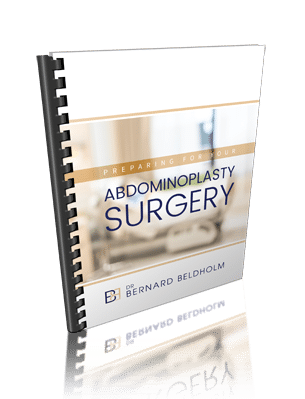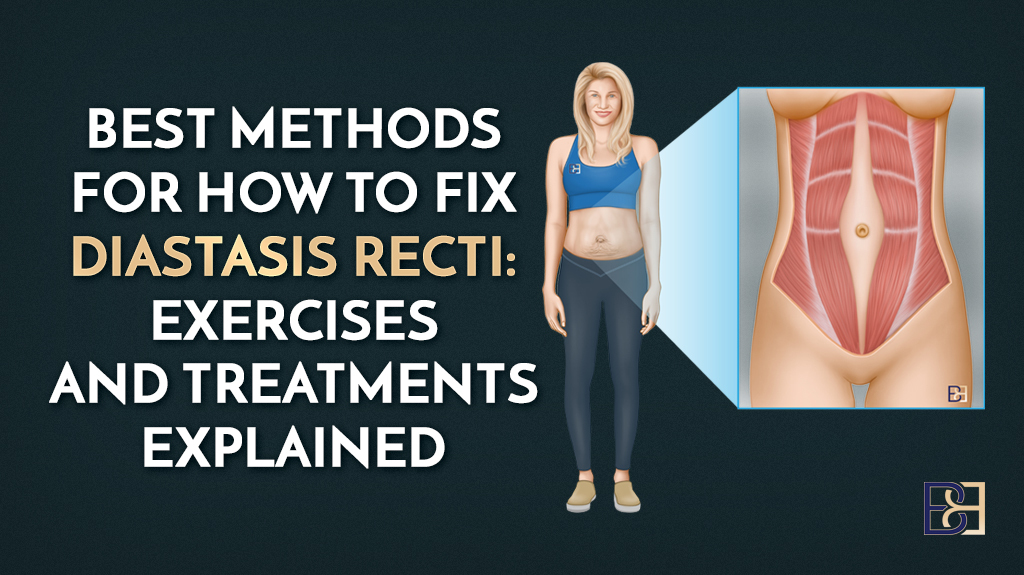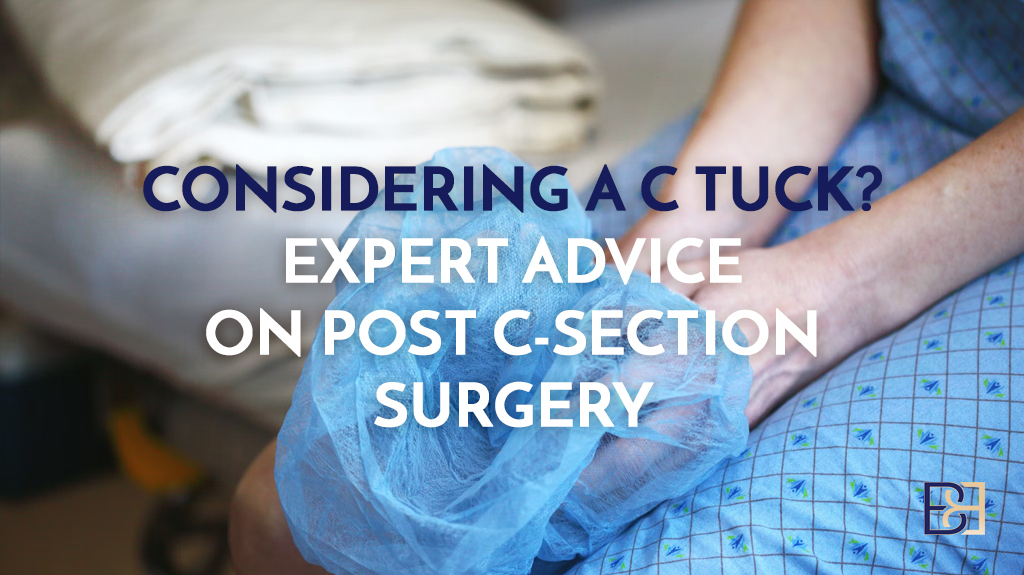From unsightly scars and uneven skin to asymmetrical results and misaligned skin flaps, issues stemming from surgical mishaps to idiopathic causes can negatively impact results of an abdominoplasty surgery. If your previous abdominoplasty surgery was dissapointing or left you with issues you never expected, a revision abdominoplasty could be the answer.
In this guide, I will cover common causes for post-surgical dissatisfaction, review the revision procedure, and go into detail about downtime, potential risks and challenges, and the recovery process.
Related Post: Dr. BB’s Guide to Belly Button (Umbilicus) Beautification And Abdominoplasty.
Book your appointment online now
Understanding Revision Abdominoplasty
Revision abdominoplasty is a specialised type of surgical procedure designed to repair, correct, or reverse unsatisfactory outcomes of a prior abdominoplasty. Whether due to weight fluctuations, subsequent pregnancies, or changes in body shape after the surgery, a revision abdominoplasty procedure aims to correct the issues and the appearance of your abdomen.
The primary goal of revision abdominoplasty is to remove excess skin and fat, re-tighten abdominal muscles, and repair any scarring or other issues from the first surgery. It can involve a variety of techniques, including scar revision, suction-assisted lipectomy (liposuction), and muscle repair (diastasis recti), depending on the patient’s specific issues.
Common Reasons for Revision Abdominoplasty
Reasons for revision surgery often include further suction-assisted lipectomy to remove excess fat or muscle repair (diastasis recti). The procedure may involve using the same incision as the original surgery or a new incision when necessary to achieve the most optimal results.
Using these techniques to correct prior complications is essential for achieving success in revision abdominoplasty.
Some patients seek revision abdominoplasty due to issues such as post-surgical complications, changes in body shape, or visible scarring. Understanding these reasons can support a more informed discussion with your surgeon about whether revision surgery may be appropriate for you.
Common reasons for undergoing revision abdominoplasty can be broadly categorised into three groups, each presenting a unique set of challenges and considerations.
- Poor initial results
- Post-Abdominoplasty Changes in Body Shape
- Post-surgical complications
Common Reasons for Undergoing Revision Abdominoplasty
Excess Subcutaneous Adipose Tissue
Abdominoplasty may be performed with or without adjunctive suction-assisted lipectomy (liposuction), depending on the patient’s presentation. In cases where excess subcutaneous adipose tissue is present in addition to redundant skin, suction-assisted lipectomy may enhance the aesthetic outcome.
However, when skin laxity is the primary concern and adiposity is minimal, suction-assisted lipectomy may not be necessary. In some instances, secondary liposuction may be indicated following an initial abdominoplasty to address residual localised fat deposits. It should be noted, however, that additional liposuction may contribute to further dermal laxity, potentially necessitating additional skin excision or revision surgery.
A revision abdominoplasty that includes suction-assisted lipectomy (liposuction) may be the solution.
Poor Scar Placement
It is crucial to place the incision correctly to achieve a good result. Placing the incision in a way that allows it to be disguisable by normal clothing is important. It’s important to note, however, that healing processes vary from patient-to-patient. Excess scar tissue can be removed and restitched during revision surgery.
Diastasis Recti (Muscle Separation)
significant weight loss, some patients may present with rectus diastasis—separation of the rectus abdominis muscles—alongside reddundant abdominal skin. When conservative management, such as physiotherapist-guided core strengthening exercises, fails to achieve functional improvement, surgical intervention may be considered.
Clinical signs may include a visible midline protrusion, particularly during abdominal contraction, or a sensation of core weakness. In such cases, rectus muscle plication performed during abdominoplasty can help restore abdominal wall integrity and improve both function and contour.
Misaligned Skin Flaps
During abdominoplasty, the objective is to achieve precise alignment of the skin flaps upon closure. However, in some cases, the initial procedure may result in malalignment, leading to irregularities and an asymmetrical or hypertrophic scar, which may be aesthetically suboptimal. Revision surgery for scar asymmetry typically involves excision of the previous scar and meticulous reapproximation of the dermal and epidermal layers to improve symmetry, surface contour, and overall integumentary appearance. In addition to enhancing aesthetic outcomes, revision may contribute to improved patient comfort and skin function.
Umbilicus Appearance
It is not uncommon for the umbilicus to have a strange appearance after abdominoplasty surgery. There are several reasons that can be the cause:
- Navel placed too high or too low
- Poor shape of the umbilicus
- Raised scars
- Stricture (a narrowing of a passageway)
- Umbilical hernia
Most navels are of an oval shape, not round. In addition, there is normally a small hood of skin at the top of the umbilicus. Though belly button shapes vary from person-to-person, it is these features that give the navel a more rounded appearance after abdominoplasty surgery. d of skin at the top of the umbilicus. Though belly button shapes vary from person-to-person, it is these features that give the navel a more roun appearance after abdominoplasty surgery.
Inappropriate Surgical Technique
Not selecting the correct abdominoplasty technique initially can lead to unsatisfactory results, especially in post-weight loss patients. One of the most frequently encountered examples of this is when a patient is left with a significant amount of loose skin following a full or extended abdominoplasty that did not adequately measure the extent of skin laxity.
Fleur-de-Lis Abdominoplasty is a more comprehensive technique that allows for more extensive removal of excess skin, correctly contouring of the abdominal area, and ultimately provides the results that the initial surgery failed to achieve.
Read more: Exploring Fleur-de-Lis Abdominoplasty
Physiological Changes
Significant weight fluctuations and pregnancy are common factors that may compromise the long-term outcomes of a previous full abdominoplasty. These physiological changes can diminish skin elasticity and disrupt the structural integrity of the abdominal wall, potentially resulting in recurrent skin laxity or soft tissue redundancy. In such cases, revision abdominoplasty may be indicated to address the excess tissue and restore a more proportionate and balanced abdominal appearance.Significant weight gain or loss and pregnancy are major factors that can alter the results of a prior full abdominoplasty surgery. These changes can affect the skin’s ability to retract, leading to the need for revision surgery. Weight fluctuations can result in more loose skin and affect the overall contour of your abdomen.
Subsequent Pregnancy
It is highly advised that patients wait to undergo a tummy tuck (abdominoplasty) procedure until their final pregnancy. However, life doesn’t always go as planned. If you had an abdominoplasty when you were planning not to get pregnant again, but later changed your mind, you may end up with loose skin after that pregnancy all over again.
Though it is not normally dangerous to get pregnant after an abdominoplasty, pregnancy will stretch the skin. And the risk rises with every year, as ageing skin has less elasticity. A revision abdominoplasty to remove loose skin after pregnancy is an excellent solution.
Re-gaining and Losing Weight
Significant weight loss (defined as 5 BMI levels) often results in loose skin around the abdomen, thighs, arms, and other areas. After undergoing an abdominoplasty it’s crucial to maintain a stable weight as fluctuations in weight can lead to skin stretching which does not retract on its own.
Touching up a Previous Abdominoplasty
As we age, our skin gets thinner, weaker, and looser, and produces much less elastin than it did in our youth. This is the case whether one has a tummy tuck (Abdominoplasty) or not. Though abdominoplasty permanently removes excess skin on the abdomen, it will not stop the skin ageing process. For patients who’ve had a tummy tuck (Abdominoplasty) 10-20 years earlier, a touch-up may be needed to tighten loose skin.
Minor abdominoplasty issues, though still disconcerting, can normally be corrected through small refining procedures, while major abdominoplasty issues often require a full re-do.
Redundant Skin
Revision surgery is important not only for aesthetic reasons but also for overall health and well-being. An issue that can normally be prevented with proper planning and design, folds of skin that develop on the scar after surgery, known as dog ears, can be particularly bothersome and require revision.
Similar to the appearance of a small dog’s ear, this condition occurs when excess skin is present at the ends of the incision. Correction of dog ears involves the removal of this excess skin. Performed under local anesthesia, this revisional procedure involves minimal pain, discomfort, or downtime
Excess Fat
One of the other major issues to discuss, residual excess fat can be removed using liposuction. Small areas of fat can be removed under local anesthesia, while larger suction assisted lipectomy revisions are commonly performed under sedation.
Wound Healing Issues
Normally occurring because of poor blood flow issues related to the patient’s health, problems involving poor wound healing may require surgical repair.
Pseudobursa
Two layers of scar tissue that form around a seroma, a pseudobursa can be managed with suction-assisted lipectomy (liposuction) or revision abdominoplasty. If the pseudobursa is located near the incision, a minor revision will suffice. A large pseudobursa will often benefit from a full abdominoplasty revision for complete removal and correction.
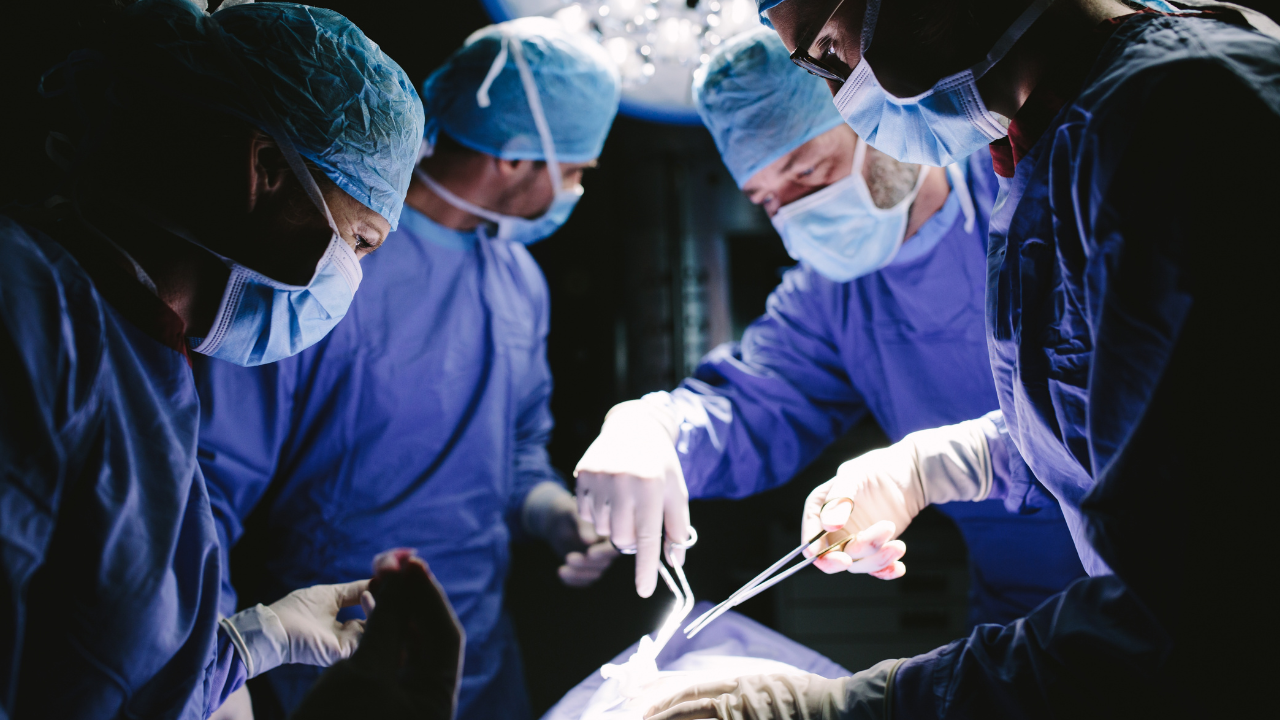
Post-Surgical Complications
If you’re considering abdominoplasty, it’s important to be aware of the potential risks. Abdominoplasty procedures carry risks, from seroma and pain to blood clots and haematoma. Development of these complications varies based on several factors, including the type of procedure performed, medical history, and lifestyle.
Infection
One of the most significant risks following an abdominoplasty, an infection may necessitate revision abdominoplasty surgery when it leads to complications that cannot be resolved with non-surgical treatments.
- Persistent or Severe Infection: When the infection doesn’t respond to antibiotics or drainage and poses a risk to the patient’s health or the surgical outcome.
- Wound Dehiscence: If the infection causes the wound to reopen or delays healing significantly, surgical intervention may be required.
- Necrosis: Infection causing tissue death (necrosis) may require surgical removal of the affected tissue to prevent further spread.
- Seroma or Abscess Formation: If the infection leads to the accumulation of fluid (seroma) or an abscess that cannot be effectively managed with drainage alone, revision surgery might be needed.
- Scarring or Contour Irregularities: Infections can lead to excessive scarring, fibrosis, or uneven contours, which may require revision sugery.
- Implant Infection (if applicable): In cases where an implant (like mesh for muscle repair) becomes infected, it may need to be removed, often requiring a revision surgery.
- Fistula Formation: Rarely, infections can result in an abnormal connection between the wound and an internal organ or the skin surface, necessitating surgical correction.
Haematoma
A haematoma (collection of blood under the skin) may require revision abdominoplasty surgery in the following situations:
If the haematoma is substantial or continues to grow, it can place pressure on surrounding tissues, compromise blood supply, and increase the risk of tissue damage or necrosis. Surgical intervention may be needed to evacuate the haematoma and prevent further complications.
Smaller haematomas often resolve on their own with time and conservative management (e.g., compression and observation). However, if the haematoma persists or shows no signs of an abnormality, surgical evacuation may be required.
Wound Dehiscence or Tissue Necrosis
A haematoma can cause the surgical wound to reopen or lead to tissue death due to impaired blood flow. In such cases, revision surgery may be necessary to debride the area, remove the haematoma, and close the wound properly.
Significant Cosmetic or Functional Concerns
Haematomas can lead to contour irregularities, asymmetry, or visible lumps under the skin. If these issues are significant, they may require surgical correction during a revision abdominoplasty.
Impact on Recovery
If the haematoma impairs healing or causes prolonged pain, stiffness, or restricted movement, surgical intervention might be recommended to expedite recovery.
Timing of Intervention
Early Revision: If identified within the first few days, a haematoma may be evacuated in a minor procedure rather than a full revision.
Delayed Revision: If the haematoma has resolved but left behind scar tissue, contour deformities, or other issues, revision surgery may be scheduled once the patient has healed from the initial procedure.
Seroma
A seroma (a collection of fluid that builds up under the skin after surgery) may require revision abdominoplasty in the following situations:
Chronic or Recurrent Seromas: If the seroma persists or recurs despite conservative treatments such as aspiration, compression garments, or drainage, revision surgery may be necessary to eliminate the underlying cause.
Significant Fluid Accumulation: If non-invasive measures fail, a large seroma that causes discomfort, tension, or visibly distorts the surgical outcome may require surgical correction.
Download our short guide: “11 Important abdominoplasty techniques that you need to know about”
Infection or Abscess Formation: If the seroma becomes infected and leads to an abscess, it will require drainage and possibly revision surgery to remove infected tissue and repair the affected area.
Tissue Adhesion Problems: Seromas can develop due to improper adherence between tissue layers after surgery. If this issue is identified, revision surgery may involve creating stronger adhesion between the layers using sutures, mesh, or other techniques.
Contour Irregularities: In cases where a seroma causes noticeable deformities or asymmetry, revision abdominoplasty may be warranted.
Fistula Formation: Rarely, a seroma can lead to the formation of a fistula (an abnormal connection between tissues or to the skin surface). This would require surgical intervention.
Non-Resolving Cavities: Seromas may persist because of unsealed dead spaces where fluid collects. Revision surgery can eliminate these spaces by re-draping the tissue or reinforcing the closure with sutures or adhesive materials.
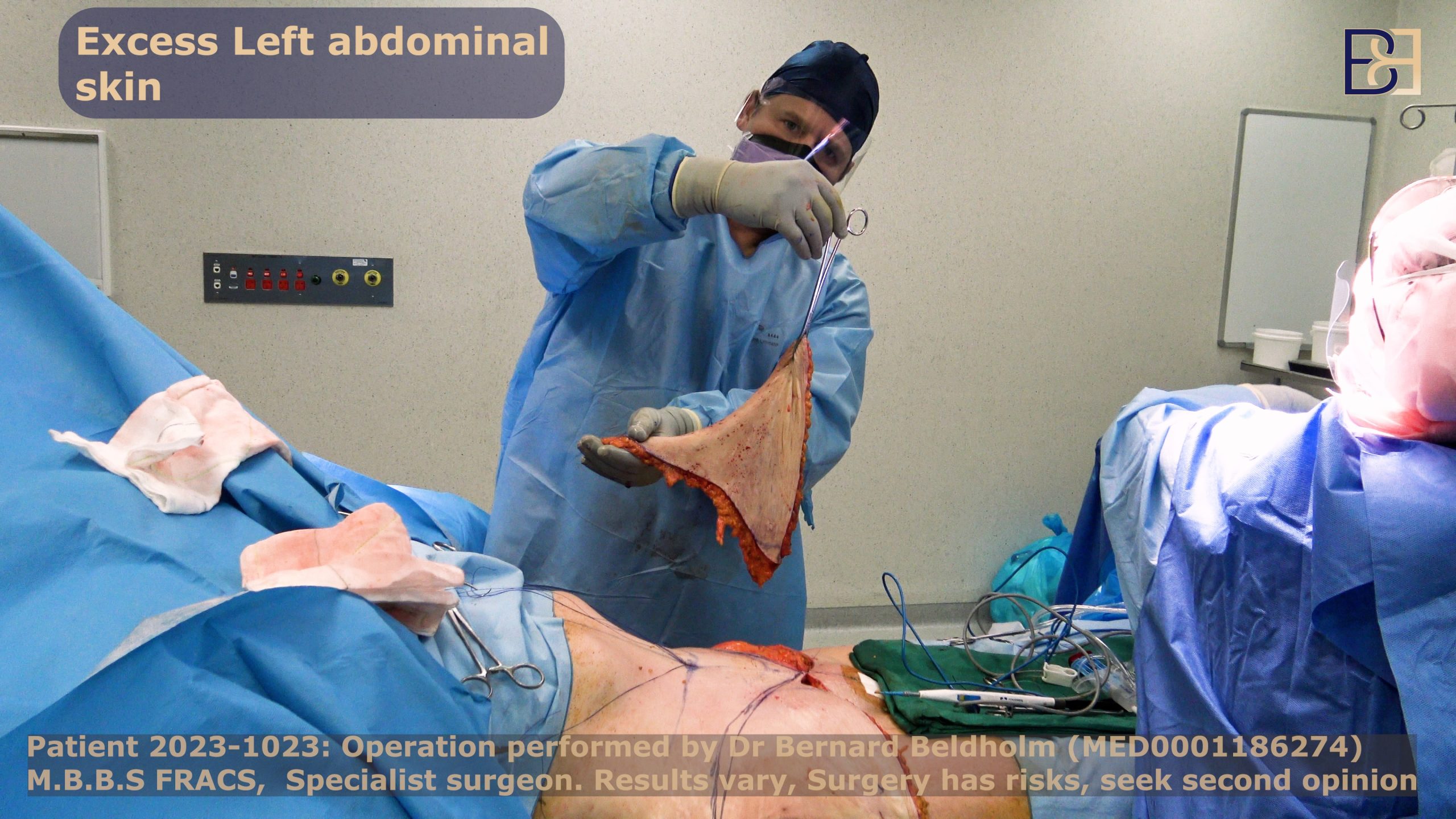
Revision Abdominoplasty Procedure
The revision abdominoplasty procedure involves several steps, starting with a thorough pre-procedure evaluation, followed by the surgical techniques used during the procedure, and concluding with the recovery procedure.
Pre-procedure Consultation
It’s vital to select a reputable, skilled, and experienced surgeon to perform revision abdominoplasty, as this procedure can be more complicated than the initial operation. A surgeon with a proven track record in revision surgeries can reduce risks and ensure positive outcomes.

During your pre-procedure consultation, your surgeon will:
- Evaluate your Health: By conducting a thorough assessment of your overall health, pre-existing conditions, and risk factors will help to determine suitability for revision surgery.
- Take Photos: Photos provide the surgeon with a visual record of the patient’s appearance and assist in the documentation of specific areas of concern such as muscle separation or excess fat.
- Discuss Surgical Options: The surgeon will review your options and the techniques available to achieve the result
- Outline Scar Placement: Additionally, the surgeon will outline the potential incision placement and potential for scarring.
- Plan Treatment: Your surgeon will recommend a treatment plan and review the surgical approach, expected outcomes, and the recovery process.
- Review Risks and Complications: Finally, the surgeon will detail potential risks involved and prepare you for possible complications that may arise.
Revision Abdominoplasty Techniques
Revision abdominoplasty can be more invasive than the original procedure due to the complexity of correcting previous outcomes.
Mini Abdominoplasty
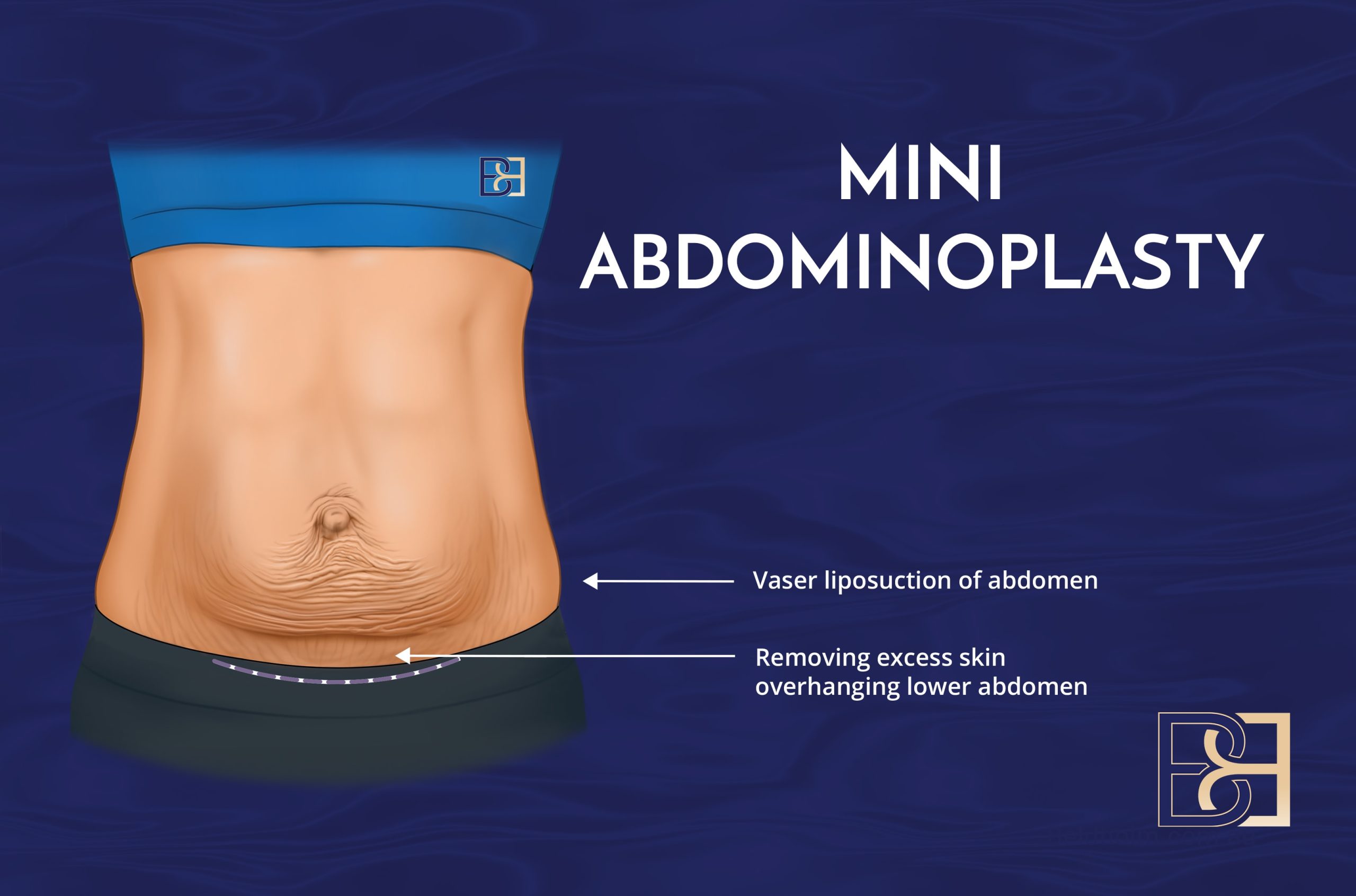
Many new moms are left with excess skin on their lower abdomen following a caesarean birth. A mini tummy tuck (Abdominoplasty) is a less invasive and less expensive alternative to a full tummy tuck (Abdominoplasty) and also has a shorter recovery time. It’s no surprise that many women opt for a mini tummy tuck (Abdominoplasty) for these reasons.
However, some women who initially choose a mini tummy tuck (Abdominoplasty) later wish they had opted for a full or extended tummy tuck (Abdominoplasty) to remove more loose skin. In such cases, they may undergo revision surgery a few years after the initial procedure. It’s important to note that a mini tummy tuck (Abdominoplasty) only treats the lower abdominal skin and does not address the loose skin on the upper abdomen. If you later decide to remove loose skin on the upper abdomen, a revision Full abdominoplasty should be considered.
- Scope: Targets only the lower abdomen, below the belly button.
- Skin Removal: Limited to a small area of excess skin.
- Muscle Repair: Typically involves minimal or no muscle tightening, depending on the patient’s needs.
- Scarring: A shorter, low horizontal scar.
- Ideal Candidate: Best for individuals with mild skin laxity and no significant muscle separation or excess skin above the belly button.
- Downtime: less recovery compared to full tummy tucks.
- Limitations: Does not address issues above the belly button or significant muscle laxity.
- Revision Surgery Likelihood:
- May require revision if skin or muscle laxity above the belly button becomes noticeable.
- Higher likelihood of patient dissatisfaction due to its limited scope.
Full Abdominoplasty
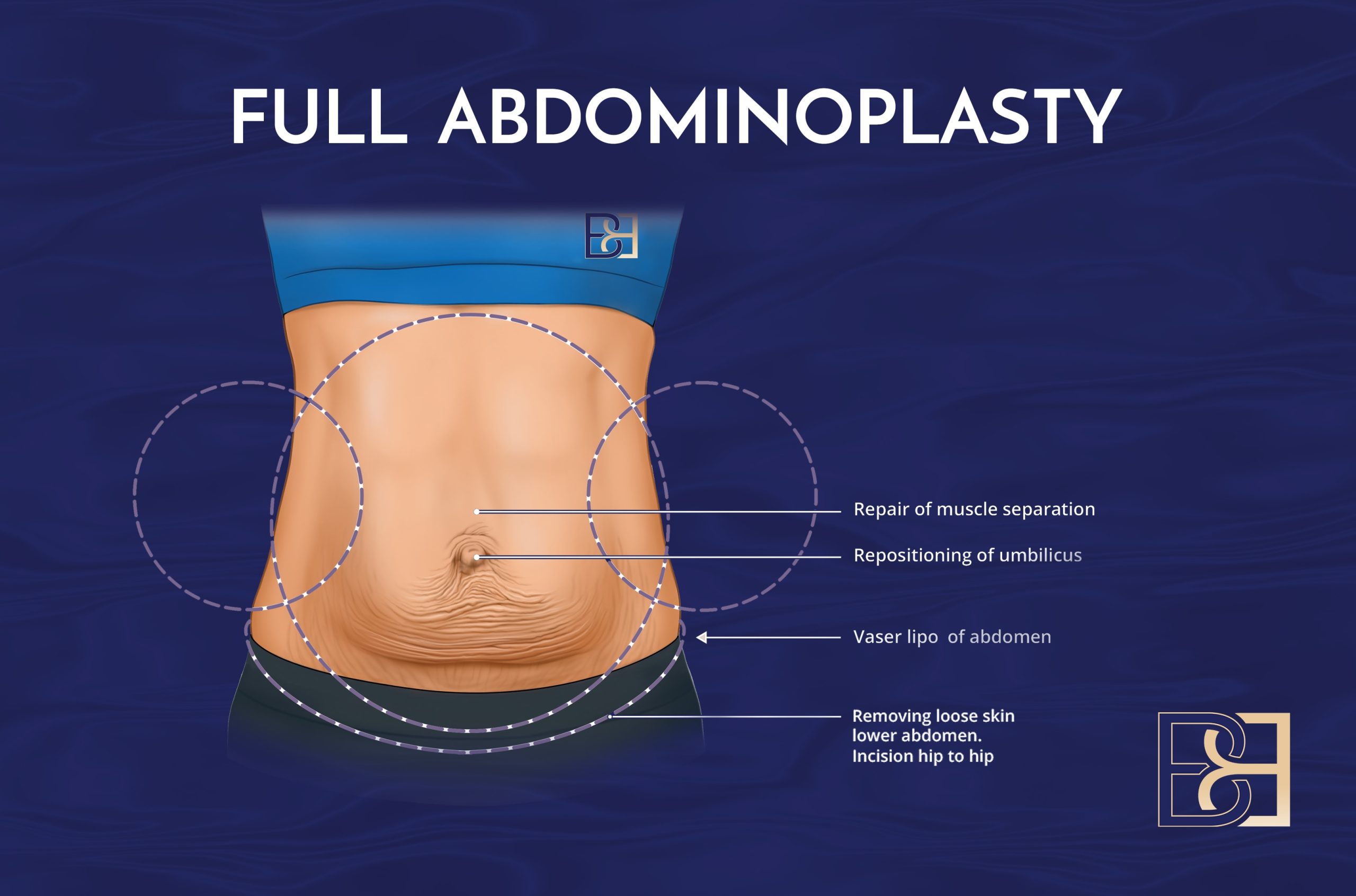
An abdominoplasty is a surgical procedure designed to remove excess skin and fat from the abdomen while tightening the underlying abdominal muscles. It typically spans the area from the lower ribcage to the pubic region, restores core strength, and creating a stronger abdominal profile. This procedure is often chosen by individuals after significant weight loss or pregnancy.
- Scope: The entire abdomen, both above and below the belly button.
- Skin Removal: Removes excess skin across a broader area, including from above the belly button.
- Muscle Repair: Includes significant tightening of the abdominal muscles (rectus diastasis repair).
- Scarring: A longer horizontal scar across the lower abdomen; may include a small scar around the belly button.
- Ideal Candidate: Suitable for individuals with moderate to significant skin laxity, muscle separation, or changes from pregnancy or weight fluctuations.
- Downtime: Longer recovery compared to a mini tummy tuck (Abdominoplasty).
- Limitations: Does not remove vertical excess skin or extreme weight loss cases as well as a Fleur-de-Lis procedure.
- Revision Surgery Likelihood:
- May require revision if laxity persists above the belly button or muscle tightening is inadequate.
- Lower revision rates compared to a mini tummy tuck (Abdominoplasty).
Fleur-de-Lis Abdominoplasty
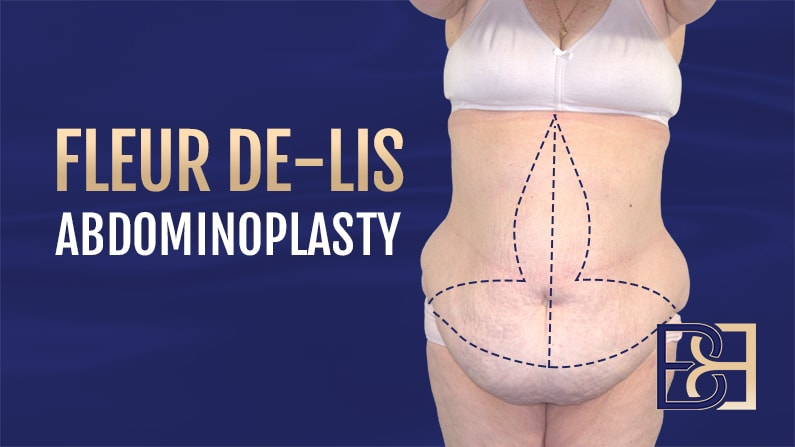
The lower likelihood of revision surgery after a Fleur-de-Lis tummy tuck compared to a mini or full tummy tuck is largely due to the comprehensive nature of the procedure.
Here’s why:
Targeted Skin Removal and Contouring
A Mini or Full abdominoplasty focuses only on the lower abdominal area (mini) or primarily on horizontal skin laxity (full). These procedures do not remove vertical excess, which might leave some areas inadequately tightened, potentially necessitating revisions.
Fleur-de-Lis removes excess skin both vertically (up and down) and horizontally (side to side). This dual-plane approach allows for a more tailored contour, particularly for individuals with significant weight loss, extensive loose skin, or unique body shapes.
Ideal for Complex Cases
Patients with massive weight loss or significant skin redundancy often require more extensive contouring. A Fleur-de-Lis approach caters to these needs better than mini or full tummy tucks, which might not sufficiently address all problem areas, leading to dissatisfaction or the need for further adjustments.
Comprehensive Muscle Repair
Fleur-de-Lis procedures typically include extensive rectus muscle plication (tightening of abdominal muscles), which provides the core’s structural support and reduces the chance of residual laxity that could demand revision.
Scar Considerations
While the Fleur-de-Lis technique results in more noticeable scars (a vertical scar in addition to the horizontal one), patients who opt for this procedure are generally prepared for this tradeoff in exchange for optimal results.
In contrast, some individuals undergoing mini or full tummy tucks may feel dissatisfied with the outcome if skin or contour issues persist, potentially leading to a revision.
Custom Fit for the Patient’s Needs
A fleur-de-lis tummy tuck is chosen when the surgeon anticipates that a more traditional approach might not fully meet the patient’s goals. This proactive decision reduces the likelihood of undercorrection, which is a common reason for revisions in less extensive procedures.
Read more: What Abdominoplasty Do I Need? Exploring Your Options.
VASER Liposuction
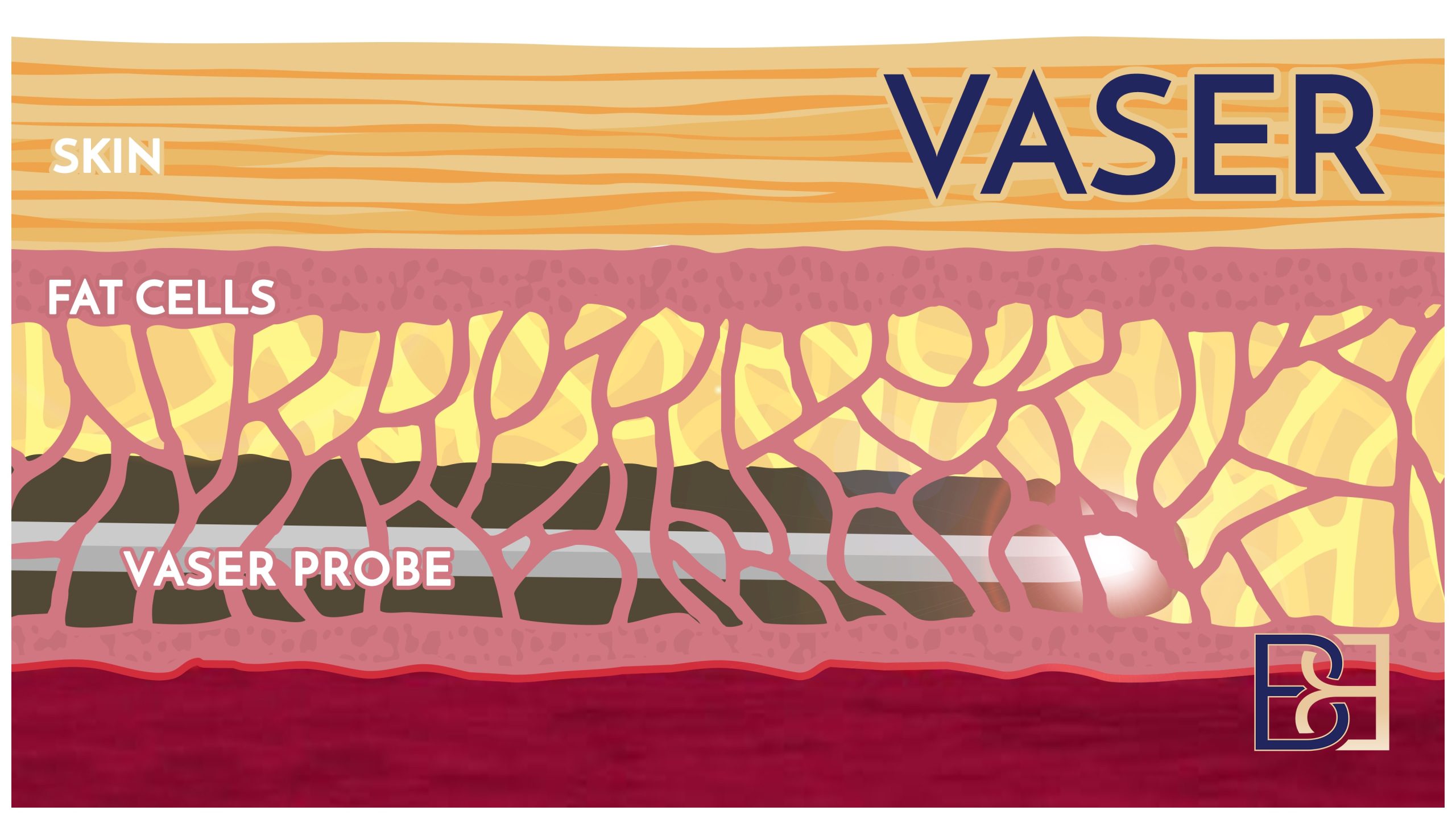
A revision abdominoplasty techniques include removing excess skin and fat, retightening muscles and fascia, and using suction-assisted lipectomy to remove residual fatty deposits. Dr. Beldholm uses techniques like VASER liposuction for effective fat removal, especially during abdominoplasty revision surgery. Scar revision surgery aims to make an abdominoplasty scar less noticeable.
Recovery Process
The abdominoplasty recovery process after revision abdominoplasty usually requires a longer period compared to the initial surgery. Most patients can resume light chores in 2-3 weeks, but full recovery can take several months. Pain medication and antibiotics are typically prescribed to manage pain and prevent infection.
Wearing compression garments for six weeks post-surgery is essential for recovery and reducing complications. Avoiding strenuous activities for at least six weeks ensures proper wound healing and avoids complications.
Managing Expectations and Emotional Well-being
Managing expectations and emotional well-being is crucial during recovery. Patients often face fluctuating emotions like excitement, anxiety, and impatience during recovery. Professional support is recommended for those struggling to manage their emotions post-surgery.
Self-care activities and open communication with friends and family can significantly affect mood and emotional well-being. Realistic expectations regarding surgical outcomes are essential for maintaining emotional health.
Getting it Right the First Time
In an ideal world, everyone would get the abdominoplasty results they hoped for after just one surgery. Sadly, things don’t always work out that way. It’s these patients who are more likely to come in for a revision abdominoplasty.
Dr Beldholm’s Final Thoughts

I want to emphasise that revision abdominoplasty is a highly effective solution for many complications or less-than-satisfactory outcomes from a previous abdominoplasty. By understanding the common reasons for needing revision surgery, the intricacies of the procedure, and the potential risks and challenges, you can make a well-informed decision about your next steps.
Through my extensive experience with revision surgeries, I’ve learned that many issues can be effectively addressed with the right approach and proper support.
Revision surgery, like all operations, has its share of complications and challenges. One of the main issues that must be is the original scar left from the initial surgery. Further, if you are seeking revision with a new surgeon, it is hard to be 100% certain how the first surgeon performed. That can make revision surgery a bit more challenging. It’s very important to see a qualified surgeon who is experienced in revision abdominoplasty.
Managing your expectations and maintaining open communication with your surgical team are key factors in a successful outcome. Together, we can work towards achieving the results you hoped for.
Frequently Asked Questions
What is a Revision abdominoplasty procedure?
Revision abdominoplasty is basically a second abdominoplasty aimed at correcting issues from a previous surgery.
What does the revision abdominoplasty procedure involve?
Revision abdominoplasty involves evaluating your situation, using techniques like suction-assisted lipectomy and scar revision during surgery, and a recovery period that can take a few months.
What are the risks of revision abdominoplasty?
Revision abdominoplasty carries risks like infection, anaesthesia complications, and a greater chance of surgical issues than the first surgery. It’s something to seriously consider before going for it!
References
- Impact of surgical consultation on outcomes in hemodynamically supported High-Risk percutaneous Coronary Intervention: insights from PROTECT II randomised study. (2016, May 1).
- Kahramanca, Ş., Kaya, O., Azılı, C., Güzel, H., Özgehan, G., & İrem, B. (2013). The role of general surgery consultations in patient management. Turkish Journal of Surgery/Ulusal Cerrahi Dergisi, 29(1), 20-24.
- Thilen, S. R., Woersching, A. L., Cornea, A. M., Lowy, E., Weaver, E. M., & Treggiari, M. M. (2018). Surgical speciality and preoperative medical consultation based on commercial health insurance claims. Perioperative Medicine, 7.
- Sorensen, M. J., Bessen, S., Danford, J., Fleischer, C., & Wong, S. L. (2020). Telemedicine for Surgical Consultations – Pandemic Response or Here to Stay?: A Report of Public Perceptions. Annals of Surgery, 272(3), e174.


